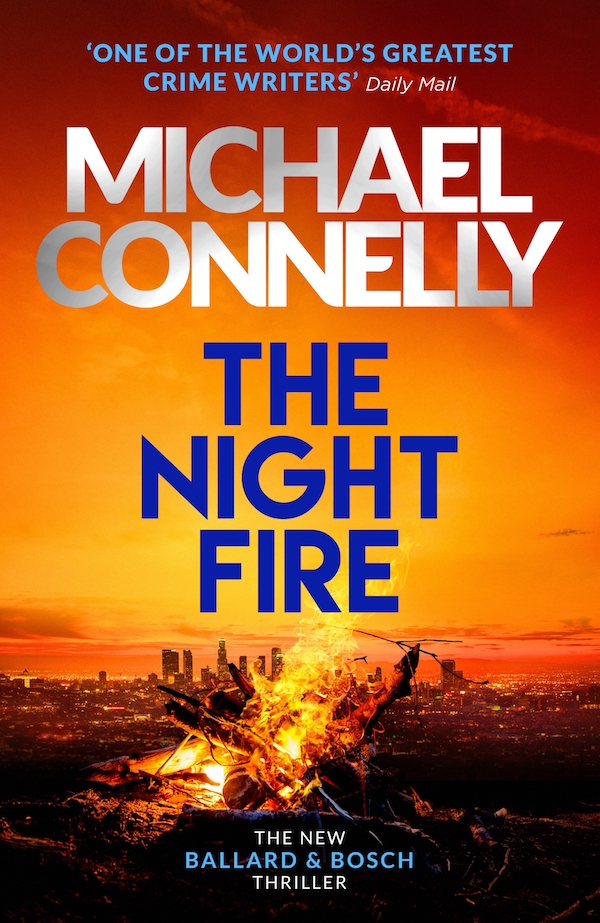Michael Connelly: The Night Fire review - unputdownable | reviews, news & interviews
Michael Connelly: The Night Fire review - unputdownable
Michael Connelly: The Night Fire review - unputdownable
Return of detective duo Ballard and Bosch for an investigation into three LA murders

Ballard and Bosch sound like some dystopian upmarket commodity. They are, but deep in with the low life. They are Michael Connolly’s new duo of detectives, one in semi-disgrace, one retired. Throw in Mickey Haller, the Lincoln Lawyer, and you’ve got one of the most fascinating and satisfying series of crime novels out there.
Harry Bosch – who crosses the line when he has to – is Connelly’s Los Angeles policeman, a Vietnam veteran who is the most frequent protagonist in the author’s novels. Now officially retired, he semi-legally investigates cold cases with the idiosyncratic and talented Renée Ballard, who was exiled to the Hollywood Division night shift when she complained of being sexually harassmed by her supervisor. Ballard lives on the beach with her dog Lola, paddle-surfs to stay sane, and has all her earthly possessions in her van.
We begin with a funeral. Bosch’s mentor John Jack Thompson is dead. His widow tells Bosch that the retired senior detective brought a Murder Book home that he wanted Bosch to have. Murder Books are files on murder cases and should never leave the precinct, so why it was effectively stolen and is being handed to Bosch is a mystery. This sets the scene for a triple-pronged investigation. There is the cold case. There is also the surprise murder of a Superior Court judge, which involves Mickey Haller as he’s convinced that the man who has been arrested for the murder is innocent, despite seemingly watertight DNA evidence. Ballard is also grappling with the tragic case of a young homeless man gruesomely burnt to death while heavily drugged in his flammable nylon shelter. The victim is referred to by Ballard, presumably as a way of distancing and protecting herself from horror, as a ‘crispy critter’.
 Connelly gives us a masterclass in keeping things straight. He alternates chapters between Bosch and Ballard, with each case typifying in different ways the textures of society and class, and police protocols and procedures, for good and ill, in LA. Homelessness, abuse, drug-taking and the inequities of the flawed justice system are treated with weight and seriousness. Yet Connelly is an entertainer. He writes great one liners and zippy conversations, all with a light hand. Coincidence and accident play their part, as well as, just like real life, the shadow of the past. It turns out that what matters most is the identity of the young man murdered decades ago. The investigation is enshrined in the stolen Murder Book and casts Bosch’s mentor in a new and unforgiving light.
Connelly gives us a masterclass in keeping things straight. He alternates chapters between Bosch and Ballard, with each case typifying in different ways the textures of society and class, and police protocols and procedures, for good and ill, in LA. Homelessness, abuse, drug-taking and the inequities of the flawed justice system are treated with weight and seriousness. Yet Connelly is an entertainer. He writes great one liners and zippy conversations, all with a light hand. Coincidence and accident play their part, as well as, just like real life, the shadow of the past. It turns out that what matters most is the identity of the young man murdered decades ago. The investigation is enshrined in the stolen Murder Book and casts Bosch’s mentor in a new and unforgiving light.
Meanwhile, the third murder, of a “good” LA Superior Court Judge, Walter Montgomery, has already reached court. How and where the DNA evidence was found has surprising and unexpected consequences. A scientific twist alters the seemingly ironclad case against Jeffrey Hersadt, whose defence lawyer is the irrepressible Mickey Haller, but who confessed after his arrest to murdering the judge.
Through it all limps Bosch. He is entering his eighth decade and has had a knee replacement. Age weighs on him. The everyday is also relentlessly omnipresent. An almost throwaway incident can be truly shocking. When Ballard is called out to a schoolgirl’s suicide, she reflects that some mysteries never get solved. Even here is the unexpected – a maternal denial because the mother did not believe the seriousness of the child’s despair. As Ballard says herself, how does one child (she thinks of her own desperate past) retain hope in the darkness and another come to believe it was gone forever?
The day-to-day incidents, processes and procedures, the unceasing work, engage our heroes and heroine. The big, surprising and complicated cases – the three murders – form the plot. The novel’s action takes place over just a few days, but though it is often urgent it is never rushed. There are surprises. We meet a female professional killer nicknamed The Black Widow, who hails, perhaps not so surprisingly, from Las Vegas, a stone’s throw from LA. There’s another suicide, a jumper from a glass skyscraper, and a bunch of corrupt corporate lawyers. An unexpected attack on Ballard nearly does for our intrepid detective.
The plot is intricate and involved, but like a twisted knot is satisfactorily untangled. The book is utterly fascinating. Connelly’s prose is impeccable, and laced with his trademark humour and cynicism. Like his detectives, for whom understanding and decoding human nature comes naturally, Connelly illuminates the human condition. It is an outstanding example of the ways in which genre fiction can cast a searing spotlight on contemporary lives in ways hardly any literary novel can match. Unputdownable.
- The Night Fire by Michael Connelly (Orion, hardback £20)
- Read more book reviews on theartsdesk
The future of Arts Journalism
You can stop theartsdesk.com closing!
We urgently need financing to survive. Our fundraising drive has thus far raised £49,000 but we need to reach £100,000 or we will be forced to close. Please contribute here: https://gofund.me/c3f6033d
And if you can forward this information to anyone who might assist, we’d be grateful.

Subscribe to theartsdesk.com
Thank you for continuing to read our work on theartsdesk.com. For unlimited access to every article in its entirety, including our archive of more than 15,000 pieces, we're asking for £5 per month or £40 per year. We feel it's a very good deal, and hope you do too.
To take a subscription now simply click here.
And if you're looking for that extra gift for a friend or family member, why not treat them to a theartsdesk.com gift subscription?
more Books
 'We are bowled over!' Thank you for your messages of love and support
Much-appreciated words of commendation from readers and the cultural community
'We are bowled over!' Thank you for your messages of love and support
Much-appreciated words of commendation from readers and the cultural community
 Justin Lewis: Into the Groove review - fun and fact-filled trip through Eighties pop
Month by month journey through a decade gives insights into ordinary people’s lives
Justin Lewis: Into the Groove review - fun and fact-filled trip through Eighties pop
Month by month journey through a decade gives insights into ordinary people’s lives
 Joanna Pocock: Greyhound review - on the road again
A writer retraces her steps to furrow a deeper path through modern America
Joanna Pocock: Greyhound review - on the road again
A writer retraces her steps to furrow a deeper path through modern America
 Mark Hussey: Mrs Dalloway - Biography of a Novel review - echoes across crises
On the centenary of the work's publication an insightful book shows its prescience
Mark Hussey: Mrs Dalloway - Biography of a Novel review - echoes across crises
On the centenary of the work's publication an insightful book shows its prescience
 Frances Wilson: Electric Spark - The Enigma of Muriel Spark review - the matter of fact
Frances Wilson employs her full artistic power to keep pace with Spark’s fantastic and fugitive life
Frances Wilson: Electric Spark - The Enigma of Muriel Spark review - the matter of fact
Frances Wilson employs her full artistic power to keep pace with Spark’s fantastic and fugitive life
 Elizabeth Alker: Everything We Do is Music review - Prokofiev goes pop
A compelling journey into a surprising musical kinship
Elizabeth Alker: Everything We Do is Music review - Prokofiev goes pop
A compelling journey into a surprising musical kinship
 Natalia Ginzburg: The City and the House review - a dying art
Dick Davis renders this analogue love-letter in polyphonic English
Natalia Ginzburg: The City and the House review - a dying art
Dick Davis renders this analogue love-letter in polyphonic English
 Tom Raworth: Cancer review - truthfulness
A 'lost' book reconfirms Raworth’s legacy as one of the great lyric poets
Tom Raworth: Cancer review - truthfulness
A 'lost' book reconfirms Raworth’s legacy as one of the great lyric poets
 Ian Leslie: John and Paul - A Love Story in Songs review - help!
Ian Leslie loses himself in amateur psychology, and fatally misreads The Beatles
Ian Leslie: John and Paul - A Love Story in Songs review - help!
Ian Leslie loses himself in amateur psychology, and fatally misreads The Beatles
 Samuel Arbesman: The Magic of Code review - the spark ages
A wide-eyed take on our digital world can’t quite dispel the dangers
Samuel Arbesman: The Magic of Code review - the spark ages
A wide-eyed take on our digital world can’t quite dispel the dangers
 Zsuzsanna Gahse: Mountainish review - seeking refuge
Notes on danger and dialogue in the shadow of the Swiss Alps
Zsuzsanna Gahse: Mountainish review - seeking refuge
Notes on danger and dialogue in the shadow of the Swiss Alps
 Patrick McGilligan: Woody Allen - A Travesty of a Mockery of a Sham review - New York stories
Fair-minded Woody Allen biography covers all bases
Patrick McGilligan: Woody Allen - A Travesty of a Mockery of a Sham review - New York stories
Fair-minded Woody Allen biography covers all bases

Add comment